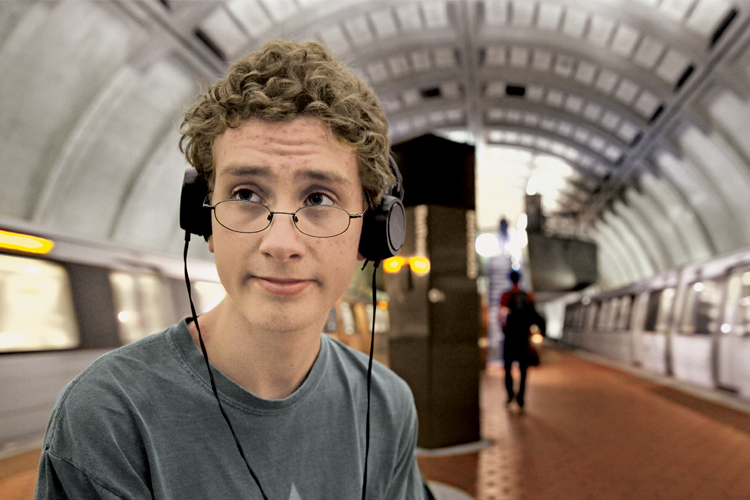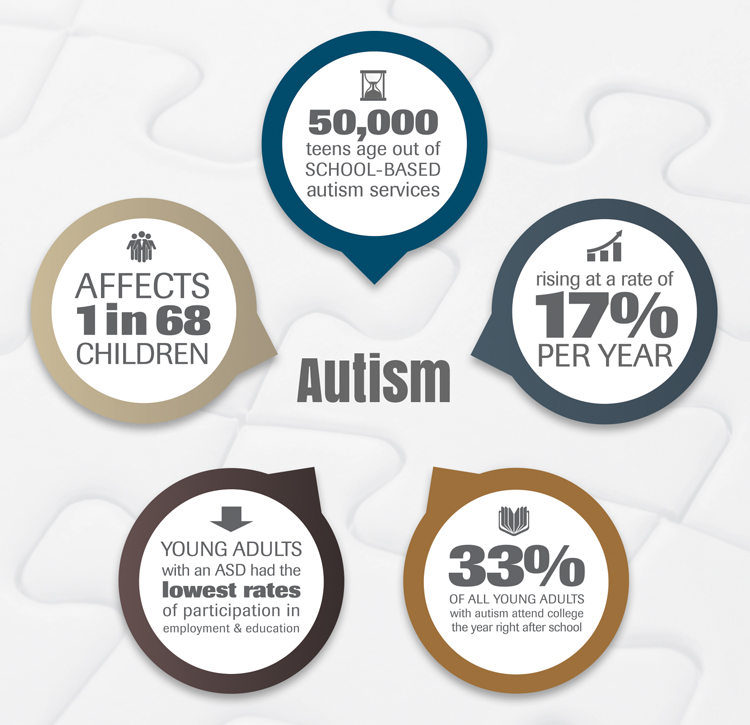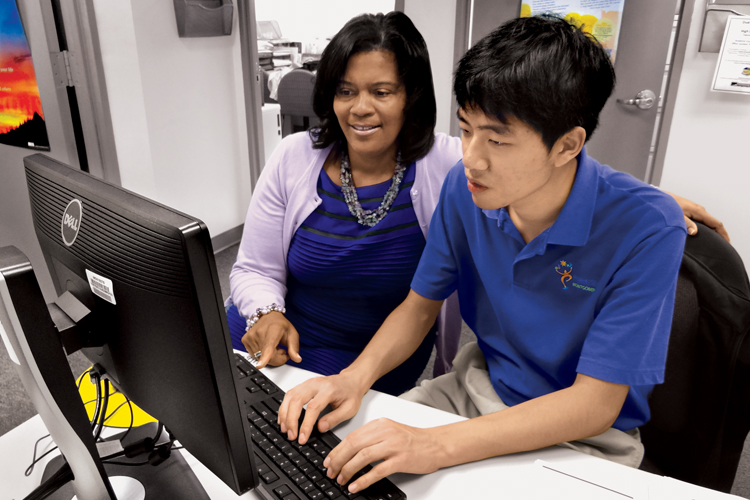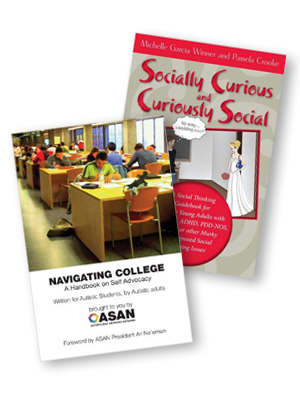Helping Students with Autism Find the Right Fit

William Rave, who self-identifies as having Asperger’s syndrome or high-functioning autism, graduated from Montgomery College in May 2015. He transferred to George Washington University this fall.
Autism spectrum disorder (ASD) is a serious neurodevelopmental disorder that impairs a child’s ability to communicate and interact with others. It also includes restricted repetitive behaviors, interests, and activities. These issues cause significant impairment in social, occupational, and other areas of functioning.2
With a 6′ 2″ frame topped with a mop of sandy blond hair, William Rave stands out in a crowd. He describes himself as curious, outspoken—and hopefully amusing. The 20 year old said, “I think I have overcome a lot of the more annoying aspects of autism.” Rave, who self-identifies as having Asperger’s syndrome or high-functioning autism, graduated from Montgomery College in May 2015. He transferred to George Washington University this fall.

William Rave celebrates with fellow honors students. He earned a 3.59 GPA in the Montgomery Scholars Honors Program.
“William came to the scholars program with an inquisitive mind and unbounded intellectual energy. When he left, he could analyze and communicate complex ideas and see their intersections. I look forward to hearing about his contributions to the world of political thought and practice for many years to come,” said Dr. Mary Furgol, director of the Montgomery Scholars Honors Program and Rave’s first-year history professor.
“This [Montgomery College] is a very good transitioning point. It is a steppingstone to more a formal college experience. You still have the structure of home life, but you have a self-guided schedule,” Rave said. “One thing that happens to a lot of autistic students is that they go to a four-year college and the scheduling is overwhelming. They end up not going to classes, not doing work, and hanging out in their rooms. They get put on probation or drop out.”
“I had a lot of stress related to the workload at first,” said Rave. “The Scholars Program is very vigorous. The first semester we had an essay due every week, starting at 750 words and up,” he says. Rave admits moving from high school to college was a major shift.
“It is a big transition,” said Sue Haddad, department chair of the College’s Office of Disability Support Services (DSS). “Students on the autism spectrum need more guidance. It’s incumbent on the student to seek out these services. They move from being ‘entitled to services’ to ‘eligible for services.’ Among the things we focus on are educating them on their responsibilities as a college student, teaching them how to navigate the College, and availing themselves of many resources available to them. It is not the same as high school, when everything was done for them.” Haddad noted the College’s population of students who self-identified as on the autism spectrum escalated from 40 to 185 over a five-year period, beginning in 2010.
“These numbers are some of the highest among community colleges in the state of Maryland,” said Lee Armstrong, program coordinator for the Maryland Division of Rehabilitation Services (DORS). So, DORS approached Montgomery College with an innovative partnership to provide additional educational—and social—support to students who have ASD.
 The DORS-Pathways Program, which started in January 2015 on the Rockville Campus, serves up to 20 students a year who provide documentation of a dis-ability, have a DORS Individualized Plan for Employment that deems college a necessary part of a vocational plan, and who register with the Disability Support Services Office at Montgomery College.
The DORS-Pathways Program, which started in January 2015 on the Rockville Campus, serves up to 20 students a year who provide documentation of a dis-ability, have a DORS Individualized Plan for Employment that deems college a necessary part of a vocational plan, and who register with the Disability Support Services Office at Montgomery College.
In the DORS-Pathways Program, students not only receive academic assistance from Montgomery College DSS counselors, but also intensive support services and individual interventions through one-on-one and small group sessions.
DORS Rehabilitation Specialist Whitney Gray works closely with DORS-Pathways students, their professors, and their DSS counselors to keep students on track academically. Furthermore, Grey helps students with career guidance, organizational and time-management skills, and interpersonal communication skills.
Rave underscores the importance and value of learning social skills: “One of the hallmarks of autism—and certainly one I have noticed in both myself and other people with autism I know—is obsession. And, because we lack intuitive empathy, we don’t realize we’re boring someone by going on about our obsession. I had to work hard to overcome that—and I think it is a very important skill I’ve learned.”
Many students with an ASD face a bleaker future than William Rave. According to a 2012 study released by the American Academy of Pediatrics, less than 35 percent of young adults with an ASD had attended college. And more than 50 percent of young adults with an ASD who left high school in the past two years did not seek employment or education. Furthermore, young adults with an ASD had the lowest rates of participation in employment and education compared to young adults in other disability categories.
“When I started at Montgomery College, if a student did not pass Accuplacer, the placement test, there was nothing for individuals with significant developmental disabilities. The subtext was: ‘Sorry, college is not for you,’” said Karla Nabors, director of developmental education/workforce access in Workforce Development & Continuing Education. During her 15-year tenure, Nabors, almost single-handedly, has established nearly a half-dozen programs benefiting students with autism—and other disabilities.

Karla Nabors supervises Steven Seo, who makes computer-generated certificates for students. Seo, who took classes in the College’s Challenge Program, now works one day a week at Montgomery College and another day for the Montgomery County Sheriff’s Office as part of SEEC Project SEARCH Montgomery.
When the GTP Program made front-page news in the Washington Post in 2003, applications doubled. In 2007, Nabors expanded the program to morning and afternoon sessions to meet the increasing demands.
To supplement the instructional component of the program, Nabors partnered with the mental health degree program at the College to give students an opportunity to complete their 200-hour practicum in the developmental programs. For more than eight years, dozens of students have completed their fieldwork in Nabors’s programs as instructional assistants.
Over the years, she has forged unique partnerships with Montgomery County Public Schools and other county agencies to educate students and place them in internships, jobs, and volunteer positions. Most recently, she teamed up with SEEC Project Search Montgomery, a school-to-work transition program placing interns with developmental disabilities like ASD in county departments and related agencies.
“For nearly 30 years, I have worked with adults and children with autism,” said Nabors. “Needless to say, the numbers are driving us to serve more and more students. Montgomery College’s programs are viable options for families who want their sons and daughters to experience college—and keep them close enough to help them manage their academic success.”
For more information on the comprehensive list of services available to students with autism at Montgomery College, visit the Disability Support Services website and the Developmental Education and Workforce Access website.
—Jill Fitzgerald
1According to estimates by the Centers for Disease Control and Prevention
2Mayo Clinic
Is Your Student Ready for College?
 For many parents, the idea of sending their college-aged child with autism onto a college campus can be daunting. A common question is: Is my child ready for this socially?
For many parents, the idea of sending their college-aged child with autism onto a college campus can be daunting. A common question is: Is my child ready for this socially?
One of the most critical skills that a parent can teach their child is to self-advocate. Preempting difficult situations is an effective method of helping your child prepare for the complex social demands of a college campus. Talking through hypothetical situations with your child is a wonderful means of preparing for tricky scenarios. Brainstorm scenes your child might encounter and work with him or her to generate solutions, scripting what they should do and say. Make sure to write things down or draw pictures to help visual learners. Social narratives are also useful tools. They are short stories that describe social situations and the desired or expected behavior in that situation. Social narratives can be a useful tool to help college-aged students know how to appropriately self-advocate.
You can also help your child prepare for future problems by discussing past events. Make a habit of doing a “daily download” with your child, making sure to ask him or her about any difficult parts of the day, reviewing what they could have done differently. Ask questions. Your child may not volunteer information because it may be difficult for him or her to know if a situation is worth discussing.
 Endless situations can be addressed in these methods, ranging from talking to a teacher about a misplaced homework assignment, to politely insisting on disability accommodations while taking a test. It’s essential to equip children with the power to stand up for themselves and express their needs.
Endless situations can be addressed in these methods, ranging from talking to a teacher about a misplaced homework assignment, to politely insisting on disability accommodations while taking a test. It’s essential to equip children with the power to stand up for themselves and express their needs.
Some resources that might be helpful on this journey include: Navigating College: A Handbook on Self-Advocacy Written for Autistic Students from Autistic Adults published by The Autistic Self-Advocacy Network (ASAN), and Socially Curious and Curiously Social by Michelle Garcia Winner and Pamela Cooke.
 Rachel Hoover ’08, MS, CCC-SLP, participated in the Montgomery Scholars Honors Program. She is a speech-language pathologist who specializes in working with young adults with autism. Follow her on Twitter @rachelchoover for helpful tips for parents and therapists.
Rachel Hoover ’08, MS, CCC-SLP, participated in the Montgomery Scholars Honors Program. She is a speech-language pathologist who specializes in working with young adults with autism. Follow her on Twitter @rachelchoover for helpful tips for parents and therapists.



“One of the most critical skills that a parent can teach their child is to self-advocate.”
🙂